Table of Contents
Giant Gourami: A Quick Summary
The Giant Gourami is a large, tropical fish native to Southeast Asia. It is known for its long, slender body and peaceful temperament, making it a popular choice for community aquariums. Giant Gouramis are typically found in slow-moving bodies of water in the wild and do well in tanks with other peaceful fish.
Giant Gourami Overview
After keeping the little fishes for a long time, a hobbyist may be tempted to try something larger for a change. The Giant Gourami can be a great option. However, one must remember that the huge fish requires a larger tank than the ‘usual fish’. Before purchasing a huge tank for the giant fish, one could still be contented with the smaller species.
Among the labyrinth fishes, giant gourami is considered the largest. Its consumption rate in terms of feeding is also quite huge. So, when one decides to purchase it, be prepared to provide lots of feeds.
The Osphronemus goramy is a popular gourami species among aquarists, especially for experts. Although they do have limitations to their growth in captivity, they still do grow their fair share. Besides their size, housing these giant fish species won’t be much of a hassle.
If you have a large tank at home and want to introduce a large fish to the tank, this is a spectacular addition. In this guide, we will discuss everything there is to know about giant gourami and their care.
| Information Chart | Giant Gourami |
| Scientific Name | Osphronemus goramy |
| Family | Osphronemidae |
| Care level | Intermediate |
| Temperament | Peaceful, sometimes aggressive in juveniles |
| Color | Gray, silver, banded coloration |
| Lifespan | Over 10 years |
| Size | Up to 27 inches |
| Diet | Omnivore |
| Minimum tank size | 200 gallons |
| Temperature | 65-90 °F |
| Water conditions | Clean with optimal filtration |
| Tank mate compatibility | Large fishes |
Giant Gourami Appearance

Also known as Osphronemus goramy, the giant gourami measures between 40 and 45 inches. In its native habitat, though, there are occasions when some were found to be more than 70cm in length. Meaning that with the right tank conditions and proper feeds, their sizes can balloon.
They usually exhibit a flat head, pointed snout, and banded coloration when they are still small. Juveniles adorn a gray to silver-blue on golden yellow to the cream background. As they age, the stripes disappear, and they are left with the greyish, almost black color.
The adults, more so males, develop what looks like a swollen head. They also have thick lips, but these are more pronounced in females. Both of them have a thick chins. Unlike other kinds of fish, at least some features can be used to distinguish males from females.
It is laterally compressed with an oval shape and has threadlike ventral fins. The presence of its labyrinth helps it to survive in waters with little or no oxygen. As it swims, it can absorb oxygen into its bloodstream. It does this by gulping the air it finds at the water surface.
The young fish features a pointed snout with lateral stripes all over the body. However, one unique trait to their appearance is that the color of the fish tends to get paler over time. Also, the head becomes larger than the body in a disproportionate way.
Coming to the abdominal region of the fish, it features a coarse spine with five soft rays, one of which serves as a tactile organ for this aquatic creature. The entire fin disposition along the body is covered in multiple numbers of soft rays.
The color of the fish, as mentioned, can go from pale yellow to golden yellow. However, when inside the tank, they mimic a silvery appearance too. In addition to those, some of the artificially bred fishes can exhibit different colors like black and gray with red lines.
As they age, not only do they grow in size, the fish also starts losing their stripes as their body becomes darker in appearance.
Lifespan of Giant Gourami
The typical lifespan of giant gourami is over 10 years. So, if you consider getting a fish to build a pet-owner relationship with, these are ideal choices. However, housing them can be a bit of a challenge, especially if you don’t have ample space for them to move around comfortably.
Giant Gourami Size
The giant gourami typically grows up to 17 inches in length on average. However, in a few exceptions, they can grow as big as 27 inches too.
When keeping giant gouramis in a home tank, the size is what poses the maximum issues. Besides finding the right kinds of tankmates, it also becomes quite difficult to find the proper setup for them over time.
They are effortless to tame and train, especially if you want to build a close relationship with them. Over time, they do recognize their owner and even let them touch and pet them.
Natural Habitat and Origin
The giant gourami is believed to be native to Java’s Greater Sunda Islands. It is also found in Borneo, Sumatra, and the Islands of Malay’s Archipelago. At the moment, they can be found in several countries where they were introduced for aquaculture reasons. Some of these countries include Australia, Mekong Basin, Thailand, Singapore, China, and Cambodia.
The gourami species is currently considered widespread because it survives several climates. In several countries, it is a crucial delicacy.
Besides being bred in captivity for hobbyists, it is also part of several cuisines. The fish is prevalent in Javan cuisine. They are bred in abundance in those villages to cook them eventually.
In the wild, the fish is typically found in abundance in rivers, lakes, and bogs. It is found in brackish waters too. The unique feature about their origin is that the fishes can breathe in humid air and even survive out of water for a long time.
They typically inhabit areas of rivers that witness floods during the rainy season. This forces them out of the water and further pushes them to migrate to other spaces. Also, they have a labyrinth organ in their body that enables them to breathe even when the dissolved oxygen levels are low.
Giant Gourami Care and Tank Set-up
Giant Gourami Tank Size and Specifications
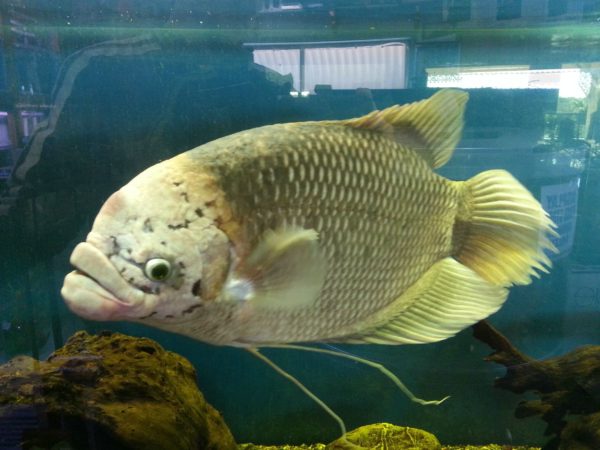
The giant gourami swims in all parts of the tank. In other words, it requires a huge tank for this venture. Requirements include at least 200 gallons of water or more. Brackish water conditions. It is not suited to full salty water conditions, so make it slight. Salinity should not exceed 10% of the average saltwater fish tank.
If you are setting up a tank for them to have a comfortable lifespan, certain factors are worth considering. Some of the most important aspects of consideration are:
Optimum Tank Size for Giant Gourami
The recommended tank size for giant gourami starts from at least 200 gallons. This means that you need a minimum tank capacity of 200 gallons to house them.
Reports from aquarists suggest that this fish can go from 7.5 cm to 50 cm in under 3-4 years, which is a living testament that they grow a lot quicker than you’d anticipate. This means that you need to be on the top of your game to match the growth rate of the fish.
The younger fish can start with a smaller tank with lesser capacity, but you need to expand as they grow. If the tank isn’t spacious for the dwellers, you need to swap it out for something larger.
As for the size, for an adult and fully grown giant gourami, you need a tank measuring 2 meters in length, 70cm in width for a comfortable living condition.
Filter type
The fish thrives best in fresh, clean water. Filtration should therefore be adequate, with water flow in moderation.
Since they are pretty large, it isn’t even a question that they create a lot of biological waste over time. Their high appetite also contributes to the waste generated.
So, it isn’t a question that having proper filtration is key. Effective filtration includes powerful water and chemical filter to balance the water conditions over time. Adequate filtration of the tank water reduces the frequency of water changing to once a week instead of every few days.
Also, this fish doesn’t enjoy heavy currents or water flow, so you need to have a separate section without water flow.
Besides water filtration, you won’t have to worry much about filtration. This is because of the labyrinth organ present in this fish. It enables them to breathe from the surface instead of just relying on the dissolved oxygen in the tank.
Substrate
One of the quintessential parts of tank decoration is the substrate. Since they have a pale yellow and silver coloration to their bodies, including dark-colored substrate is considered ideal.
Besides finer substrate, they also do well with larger snags and smoother stones at the bottom of the tank. Although they aren’t bottom dwellers, they tend to move around the tank’s perimeter, scoping the environment.
Water Parameters for Giant Gourami
Just because the giant gourami has a labyrinth organ doesn’t mean they don’t need water change. This is where you need to understand the needs and requirements all the more. Not cleaning the water frequently can end up causing tissue injury.
Expert aquarists suggest renewing the water regularly. Besides that, one should renew 25% of the water volume every day to keep them in the best of health.
Here’s a quick breakdown of water parameters you need to follow:
Water Temperature
The ideal water temperature for giant gourami is between 65-90 °F. This suggests that the fish enjoys living in mildly cold to mildly warm water temperatures. This is what they get in the wild, and while it is challenging to mimic the exact water parameters highly, you can try the maximum possible.
pH Level
The perfect water pH level for giant gourami is between 6-8. This depicts that they either need slightly acidic or slightly alkaline water pH levels.
Water Hardness
The ideal water hardness for a giant gourami tank can be up to 30 dGH. This might seem like a lot, to begin with, but that is the permissible limit, so try to keep the water hardness below the said limit.
Giant Gourami Tank Landscape
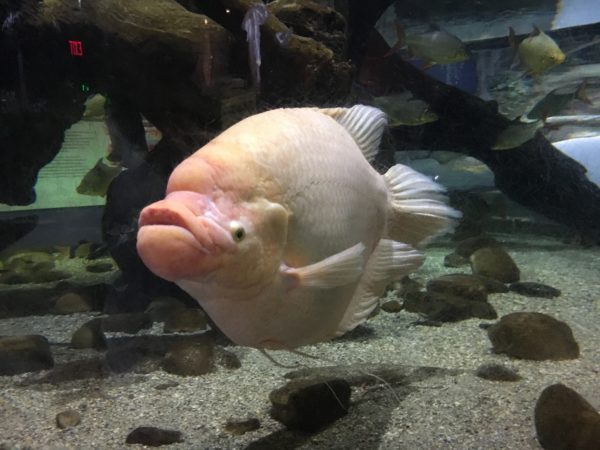
Since giant gouramis are large and active throughout the day, the tank setup needs to be done accordingly. The last thing you want is to keep them in a community tank that houses a lot of decorations.
They like their space and need open spaces in the tank to move around and explore. Besides the dark substrate, include large stones and snags in the bottom of the tank. This will serve as shelter for the gourami to relax from time to time.
As for plants, integrate plants that have coarse leaves. Anubis makes for a good pastime snack for the gouramis. Since these fishes are large and have a good appetite, including live plants is a waste. They will gobble them down as snacks now and then.
The bottom or base of the tank can be filled with fluctuant like Amazon frogbit. These are fast-growing species and support the overall ecosystem in the tank. When introducing snags to the tank, ensure that you don’t include the ones with rigid and sharp knots. This puts them at getting injured.
Another essential part of the tank decoration is the space between the water surface and the lid. Since the giant gourami has a labyrinth organ, they will come up to the surface for some air. Just ensure that they have enough space on the top to do it comfortably.
Feeding Giant Gourami
Typically, the giant gourami is an omnivore. In the wild, they are known to feed on algae and other smaller fishes. Frogs, worms, and different kinds of dead meat are their delicacy.
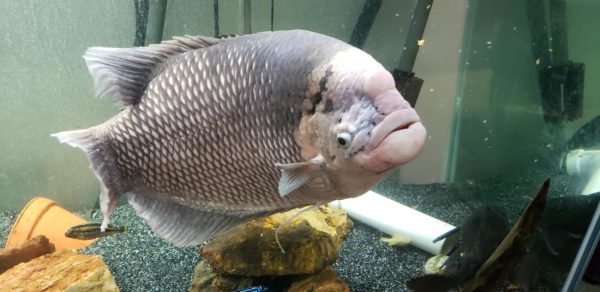
Cooked foods, including meat, boiled potatoes, or vegetables, are another delicacy for the gourami. Beef from mammals can be avoided as they are not easily digested by the fish.
Frozen or live brine shrimp can be offered as a treat, especially when the fish now recognizes the owner. Bloodworms are another special treat to be delivered.
Avoid feeding the live gourami fish as this may be expensive in the long run. As soon as it is purchased, it ought to be trained on the kinds of foods listed above. Fish in captivity often adjust to the types of feeds frequently offered.
More than what you are feeding giant gourami, it is about how much you are feeding them. Overfeeding can cause issues with their health, so it is advised that you stray off of that. Also, if you are buying the fish as an adult, enquire about their usual eating habits. Introducing them to an entirely new diet when they are an adult can cause rejection of food.
Since they scarf down pretty much anything, we’d recommend buying them as a baby. This way, you can adapt them to a regular diet that is good for them and recognized. Also, if you are sticking to JUST a plant-based diet, you are mistaken.
Giant gourami is an omnivore that eats aquatic plants, amphibians, small fishes, and even earthworms in the wild. So, devoiding them of that will result in malnutrition. Animal protein contributes to balanced development, so include them in the diet without fail.
Giant Gourami Behavior and Temperament
It is a community fish but maybe a loner too. They can share a tank with other big fish but may not tolerate their fellows of the same species.
The males tend to be more aggressive towards each other, more so during breeding periods.
The adults become quite aggressive when their tank is small. To avoid this, ensure the tank is big enough to accommodate the gourami and other tank mates.
When they stay in the same tank with the same setting for a long time, they tend to own or possess the habitat. In case there is a new addition, the giant gourami is seriously bullied.
If there is a vast tank and plenty of feeds to offer the giant gourami, this can be an excellent consideration for a hobbyist.
Giant Gourami Tank Mates
It is the smaller juveniles that are a little aggressive and territorial. Once they grow and mature to an adult, their aggression gradually reduces, making it easier for them to stay with pretty much any suitable tank mate.
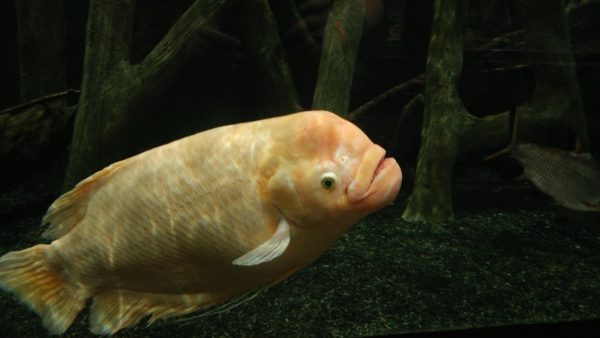
The dominating variants are often found to become territorial with their kind. However, these reactions are usually short-lived and very rare. Typically, if you house giant gourami, house them alone in the tank or as a couple. Anything above that will cause a riot now and then.
If you plan on keeping 4-5 giant gourami in a home tank, you’d need something with a lot of capacity. For a community tank, you need to avoid putting them with smaller fish, especially one that mimics their needs in the wild.
For the ideal experience, house them with large cichlids and catfishes for better harmony. These species like to keep to themselves, so you won’t have to worry about keeping them together. Besides that, larger fish species make good additions to a gourami tank. Anything that is comparably smaller than the giant gourami will end up being a meal for them.
Some of the best tank mates include:
- Oscar
- Flowerhorn
- Blood parrot
- Green terror
- Redtail catfish
- Pleco
- Clown loach
- Dojo loach
- Silver Dollar
- Pacu
- Silver arowana
Again, avoid putting them with fish species that are smaller in size. This imposes risks and stress on the smaller fish, making them experience premature death eventually.
Breeding Giant Gourami
Differentiating males from females is possible as the males have more pointed anal and dorsal fins. Females have thicker lips than males, and their dorsal fins are rounder. Anal fins are rounder too.
Giant gouramis build nests from plant bits during breeding periods in the wild. They do this mainly in May and April. Spawning, on the other hand, happens all year round.
Breeding this fish in captivity is not a real problem, but providing a massive tank for this process can be very difficult.
They mature at around six months.
The female lays mature eggs of between 1,500 and 3,000. These are lighter than water and will float on the surface. The male then gathers all these eggs in its mouth and takes them to the nest. After about 40 hours, the eggs hatch. The male guards the fry for at least 14 days.
The fry grows relatively fast and may begin feeding after about one week. Provide light fish feeds at this time.
In the wild, the male fish is responsible for guarding and taking care of the offspring for up to 3 weeks. However, the same behavior isn’t exhibited in captivity. Once the fry starts swimming, you need to remove the male giant gourami from the tank.
During the development period, aquarists need to reduce the water level to 10 cm. Maintain the same for up to 30 days. This is to support the formation of the labyrinth organ in the fish. During this period, the juveniles will come up to the surface, gasping for air.
Above everything, the main influencing factor about the breeding process is the size of the tank. If the tank size isn’t optimal, you won’t get proper nesting and spawning.
Giant Gourami Diseases and their Treatment
You’d think that given that they are larger fishes, they would be more prone to diseases. That isn’t the case, though. Giant gourami is an extremely hardy fish and can stay disease-free if the aquarium water is well-maintained.
However, there are exceptions too. There are a few selective diseases that the fish species can struggle with. Some of the important ones include:
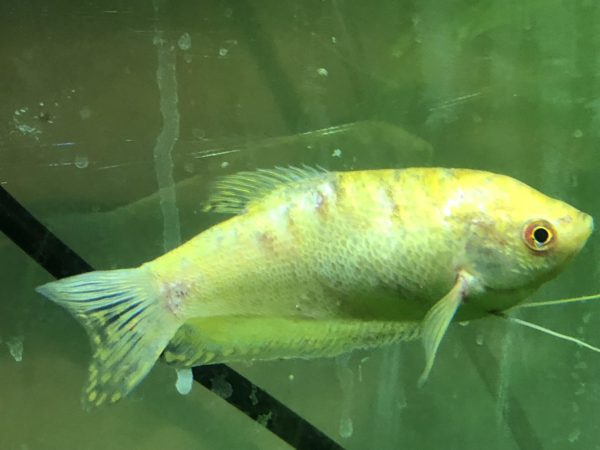
- Bacterial infection
- Constipation
- Hole in the head disease
More or less, every one of these diseases is due to poor water and living conditions. So, be vigilant of the water parameters and change the water as instructed.
The best way to prevent diseases is by ensuring that you quarantine any and every item for two weeks before introducing them to the tank. Every plant or other decorations need to be cleansed and rinsed with an aquarium anti-bacterial treatment before you put them in the tank.
Are Giant Gourami Right for You?
It is easier to straight out say yes. However, with the kind of efforts that giant gourami needs, you need to make an informed decision. The first criteria to tick off is the size of the tank. If you don’t have enough space in your home for a larger tank of at least 100 gallons capacity, consider another fish.
However, if you do have the space to accommodate, go for it. Besides the larger tank space, they don’t require much of any other effort, so you are pretty much good to go. Be prepared to cater to their feeding habits because they do need multiple large feedings.
FAQs
How fast do Giant Gourami grow?
The growth of giant gourami is heavily dependent on their feeding and lifestyle. Typically they can easily grow one inch per month with all the correct parameters, which is a lot for a fish species. This is why you need to be prepared to support their growth with a large tank.
Can multiple Giant Gouramis live together?
Although it isn’t impossible, we’d recommend not keeping many together. The dominant one can become territorial and inflict signs of aggression. Also, keeping multiple in one tank means that you need to have a huge aquarium at home. Technically, keeping numerous in one tank doesn’t seem like a practical choice.
Are Giant Gouramis intelligent?
Yes, they are brilliant and know how to swerve and adapt to their surroundings. You need to be on the top of your feet to keep up with them.
Conclusion
The Osphronemus goramy or Giant gourami has a terrible reputation for just being big. Although unusual, they do make a great addition to a home aquarium. All you need to do is follow the correct care instructions and feed them right. Since they are hardy, you don’t have to go out of your way to do anything that takes a lot of time, effort, or money.
So, if you consider adding them to your tank, we’d say you go for it. We hope this article gives you all the insight you need to take care of the fish the right way.
No related posts.
